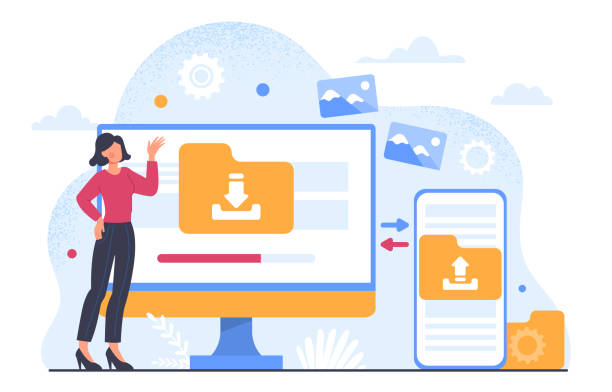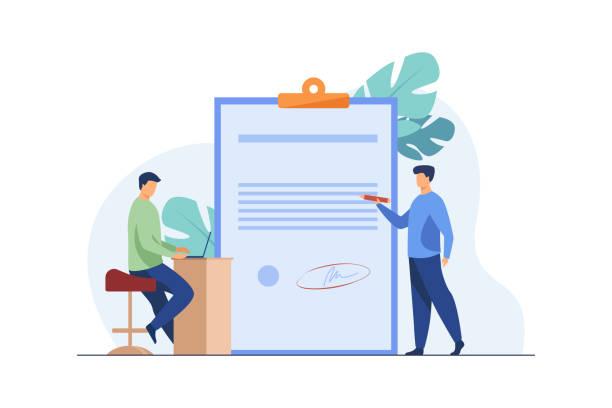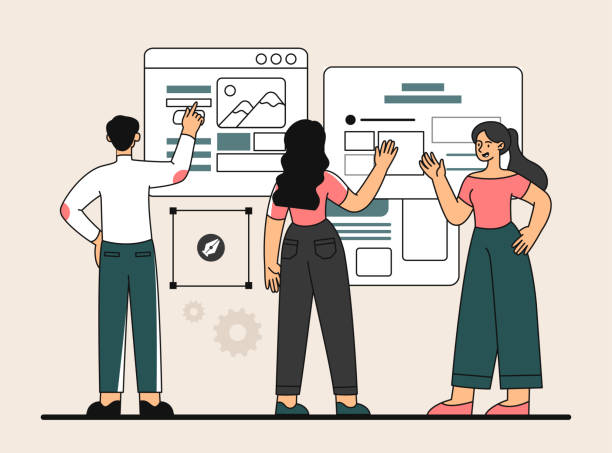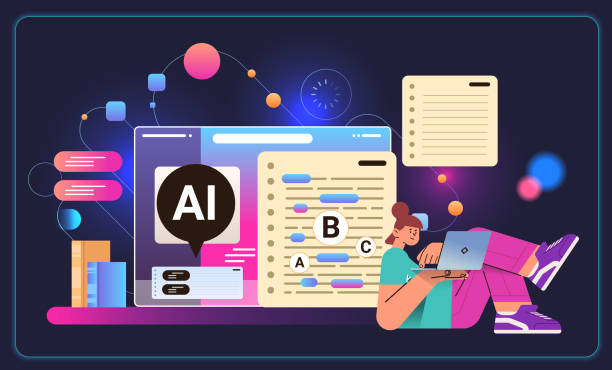Introduction to SEO-Optimized Website Design: Its Concept and Importance

In today’s digital world, merely having a website is not enough; your website needs to be seen.
This is where #SEO-optimized website design and website optimization for search engines become important.
Simply put, SEO-optimized website design is a process through which your website’s structure, content, and coding are shaped in a way that makes it easily understandable and rankable for search engines like Google.
This means increasing your website’s chances of appearing high in search results, which in turn means an increase in visitors and ultimately, potential customers.
SEO is not just a marketing technique, but a comprehensive approach to web structuring that also provides a better user experience.
This approach ensures your site is technically sound, rich in content, and visually appealing.
Neglecting these principles can lead to even the best content getting lost among the vast amount of information on the web.
Therefore, any business aiming for online success must prioritize SEO-optimized website design.
This is a long-term investment that will yield significant returns in attracting organic traffic and enhancing your brand’s credibility.
Don’t have a corporate website yet and missing out on online opportunities? With professional corporate website design by Rasawp,
✅ Double your business credibility
✅ Attract new customers
⚡ Free consultation for your corporate website!
Key Elements of a Search Engine Optimized Website Design

To have an #SEO-optimized website and succeed in search results, several key factors must be considered, forming the foundation of any SEO strategy.
The first and most important element is keyword research.
Understanding the phrases your target audience uses to find your products or services is the initial step in creating relevant and targeted content.
Following that, content optimization based on these keywords involves their natural and logical use in text, titles, meta descriptions, and image alt tags.
The site’s URL structure is also highly important; short, descriptive URLs containing keywords are more beneficial for both users and search engines.
Additionally, correct use of Heading tags (H1, H2, H3, etc.) helps search engines understand the structure and importance of different sections of your content.
Images should also be optimized, including compression for loading speed and using descriptive alt tags.
Responsive Design, which displays your site well on all devices, is another critical factor for Google.
Finally, website loading speed directly impacts user experience and SEO ranking; a fast-loading site keeps users satisfied and reduces bounce rate.
Together, these elements ensure a powerful SEO-optimized website design.
Technical Aspects of SEO-Optimized Website Design: Speed, Mobile, and Structured Data

Technical #SEO aspects play a vital role in an efficient #SEO-optimized website design.
In fact, even with excellent content, if your website has technical issues, search engines will struggle to crawl and index it.
Website loading speed is one of the most important factors.
Today’s users are impatient, and a slow website can lead to page abandonment.
Tools like Google PageSpeed Insights can help you identify and resolve speed issues.
Optimizing images, using caching, compressing code (HTML, CSS, JavaScript), and choosing suitable hosting are ways to increase speed.
Mobile-Friendliness is no longer an option but a necessity.
Given the increasing use of mobile phones for internet access, Google uses a Mobile-First Indexing approach, meaning it prioritizes your site’s mobile version for ranking.
Google’s Mobile-Friendly Test tool can check your site’s status.
Structured Data or Schema Markup helps search engines better understand your site’s content and display it more richly in search results (Rich Snippets).
This can include product information, reviews, events, recipes, and so on.
Correct use of this data can increase the click-through rate (CTR), even if your ranking doesn’t change.
An SEO-optimized website design also involves regular checks of the robots.txt file and XML sitemap to ensure search engines can easily find and crawl your important pages.
Resolving crawl errors and ensuring the overall technical health of the site through tools like Google Search Console is crucial for maintaining and improving SEO rankings.
These technical factors form the backbone of a successful online presence.
| Technical Factor | Description | Importance for SEO |
|---|---|---|
| Website Loading Speed | The time required to fully display page content to the user. | Main Google ranking factor, direct impact on user experience and bounce rate. |
| Mobile-Friendliness | The ability of the website to display correctly and function properly on mobile devices. | Search engines use a Mobile-First Indexing approach, essential for ranking. |
| Structured Data (Schema) | Codes that help search engines better understand page content. | Increase in Rich Snippets and CTR in search results. |
| Security (HTTPS) | Using the secure SSL/TLS protocol for encrypting communications. | A small ranking factor, but very important for user trust and search engines. |
Common Website Design Mistakes and Their Impact on SEO

On the path to achieving a successful #SEO-optimized website design, many businesses unintentionally make mistakes that can render their SEO efforts ineffective.
One of the most common mistakes is neglecting user experience (UX).
A site with complex navigation or a poor design that confuses users will have a high bounce rate, even if it’s optimized for keywords, sending a negative signal to search engines.
Another mistake is keyword stuffing.
Filling the text with keywords is not only unpleasant for users, but search engines also identify it as a spam technique and penalize the site.
Lack of mobile optimization, as mentioned earlier, is a grave mistake.
In an era where most searches are conducted via mobile, a site that doesn’t perform well on mobile will lose significant traffic.
Also, neglecting high-quality and unique content is another error.
Copying content from others or producing worthless and superficial content not only adds no value for users but is also useless from an SEO perspective.
Google aims to provide the best and most relevant answers to user queries.
Using unoptimized and bulky images can also drastically reduce site speed and harm user experience.
The absence of proper internal linking between different pages of the site, as well as not having a healthy and natural backlink strategy, are other factors that can hinder good site rankings.
Finally, lack of regular content updates and SEO data analysis will cause your site to fall behind in the competition.
A successful SEO-optimized website design requires continuous monitoring and error correction.
Are you frustrated with your e-commerce site’s low conversion rate? Rasawp transforms your e-commerce site into a powerful tool for attracting and converting customers!
✅ Significant increase in visitor-to-buyer conversion rate
✅ Exceptional user experience to boost customer satisfaction and loyalty⚡ Get a free consultation from Rasawp!
Content Strategy for Achieving a Successful SEO-Optimized Website Design

Content is king; this phrase never gets old in the world of #SEO.
For an #SEO-optimized website design to be truly effective, it must be backed by a strong content strategy.
Content should not only be excellent in quality but also structured in a way that is both appealing to users and understandable to search engines.
The first step in this strategy is accurately identifying the needs and questions of the target audience.
Your content should answer these questions and solve user problems.
This can include blog articles, guides, infographics, videos, and even product pages.
Comprehensive keyword research is crucial here; not just primary keywords, but also LSI (Latent Semantic Indexing) keywords and long-tail keywords that more accurately reflect user intent.
Content should be comprehensive and in-depth, not superficial.
Google values content that demonstrates authority and subject matter expertise.
Using credible data, statistics, expert opinions, and referencing reliable sources can increase your content’s credibility.
Content readability is also very important.
Using short paragraphs, subheadings, lists, and relevant images helps improve user experience and better understanding of the content.
Your content should be updated regularly.
Outdated information is not only useless for users but can also decrease your SEO ranking.
Creating a content calendar and planning for content production and updates is an inseparable part of SEO-optimized website design.
Don’t forget that the ultimate goal is to provide value to the user; search engines are becoming increasingly smarter and recognize the true quality of content.
Latest SEO Trends and Their Impact on Website Design

The world of #SEO is rapidly evolving, and staying aware of the latest trends is essential for maintaining an effective #SEO-optimized website design.
One of the most significant changes is Google’s increasing emphasis on Core Web Vitals.
These metrics include Largest Contentful Paint (speed of loading the largest content element), First Input Delay (delay of the first user interaction), and Cumulative Layout Shift (visual layout shifts), directly impacting user experience and, consequently, SEO ranking.
Web designers must optimize their code and ensure that sites not only load quickly but also have high visual stability and responsiveness.
Artificial intelligence and machine learning (such as Google’s RankBrain and BERT algorithms) are increasingly influencing how content is understood and ranked.
This means that content should not only include keywords but also be written naturally and with a deep understanding of the topic to correctly cover the searcher’s intent.
This emphasizes the necessity of producing comprehensive, authoritative, and high-quality content.
Voice Search is also growing, and this impacts keyword research.
Users tend to use longer, more conversational queries in voice search.
Therefore, optimizing content for these types of searches, including answering common questions and using natural language, is an integral part of modern SEO-optimized website design.
Finally, Local SEO has gained more importance for physical businesses.
Presence on Google My Business, collecting customer reviews, and optimizing for “near me” searches are among the strategies that should be considered.
A modern SEO-optimized website design must be flexible and able to adapt to these continuous changes to remain at the forefront of the competition.
Essential Tools and Resources for Monitoring and Improving SEO-Optimized Website Design

To ensure that an #SEO-optimized website design is continuously improving and performing optimally, the use of #tools is an undeniable necessity.
These tools help you monitor your site’s performance, identify issues, and discover new growth opportunities.
One of the main and most vital tools is Google Search Console (GSC).
This free tool provided by Google offers valuable information on how Google sees your site, crawl errors, indexing issues, keywords you rank for, and even security problems.
Every website owner should set up GSC.
Google Analytics (GA) is another essential tool for analyzing user behavior on your site.
With GA, you can see where users come from, how long they stay on the site, which pages they visit, and what your conversion rate is.
Combining GSC and GA data provides a comprehensive view of your site’s SEO performance and user experience.
For keyword research and competitor analysis, tools like Ahrefs, Semrush, and Moz Keyword Explorer are very powerful.
These tools allow you to check search volume, keyword difficulty, analyze competitor backlinks, and discover new opportunities.
In the realm of site speed, Google PageSpeed Insights and GTmetrix are invaluable tools that identify technical issues affecting speed and offer solutions for improvement.
To check for technical SEO issues, tools like Screaming Frog SEO Spider can help you find broken links, improper redirects, title and meta description problems, and other technical issues.
A combination of these tools enables you to continuously monitor and optimize an SEO-optimized website design, which is vital for maintaining an edge in the competitive online space.
| Tool Name | Main Use | Type (Free/Paid) |
|---|---|---|
| Google Search Console | Monitoring site performance in search results, crawling, and indexing. | Free |
| Google Analytics | Analyzing user behavior, traffic sources, conversion rates. | Free |
| Ahrefs / Semrush | Keyword research, competitor analysis, backlink review. | Paid (Limited Free Versions) |
| Google PageSpeed Insights | Checking website loading speed and providing improvement suggestions. | Free |
| Screaming Frog SEO Spider | Crawling the site and identifying technical SEO issues (broken links, duplicate titles). | Paid (Limited Free Version) |
Success Stories in SEO-Optimized Website Design

Perhaps you’ve wondered if #SEO-optimized website design can truly make a significant difference in a business’s success? The answer is a resounding yes.
There are countless examples of small and large businesses that, by investing correctly in optimizing their websites, have achieved remarkable success.
One such inspiring story could be about a local online store that, before SEO-optimized website design, only had access to its regional customers.
By optimizing local keywords, creating content relevant to the region’s needs, and improving site loading speed, this store managed to achieve top rankings in Google search results for phrases like “buy in [city]”.
The result was a 300% increase in organic traffic and, consequently, significant growth in online sales.
Another example could be an educational blog in the health sector.
This blog, by producing specialized and in-depth content on highly searched health and #mental health topics, and by adhering to all principles of an SEO-optimized website design including strong internal linking, image optimization, and the use of structured data for rich snippets, managed to become a primary resource for users in this field.
The blog’s traffic not only increased astronomically, but user credibility and trust in it also multiplied, which in turn led to new collaboration and revenue opportunities.
Even large companies do not overlook the principles of SEO-optimized website design.
The redesign of a financial services company’s website, focusing on improving Core Web Vitals and optimizing for voice search, led to a significant reduction in bounce rate and increased user time on site.
This, combined with content optimization for keywords related to financial services, helped the company strengthen its position in a competitive environment and attract new clients.
These stories demonstrate that SEO is not just a science, but an art that can transform businesses.
Is your e-commerce site ready to attract maximum customers and increase sales? Rasawp transforms your online business with modern and efficient e-commerce website designs.
✅ Increased speed and improved SEO
✅ Excellent user experience on mobile and desktop⚡ Get a free e-commerce website design consultation from Rasawp!
Measuring SEO Performance and Continuous Optimization Process

Implementing an #SEO-optimized website design is just the beginning; the crucial part is #measuring performance and the continuous optimization process.
SEO is not a one-time process but requires constant monitoring and adjustment to keep pace with Google’s algorithm changes and user behavior.
The first step in this path is defining Key Performance Indicators (KPIs).
These indicators can include keyword rankings, organic traffic, bounce rate, time on site, conversion rate, and the number of backlinks.
After defining KPIs, you must regularly collect and analyze data from tools like Google Search Console and Google Analytics.
Analyzing this data shows you which parts of your SEO-optimized website design strategy have been effective and which areas need improvement.
For example, a high bounce rate might indicate user experience issues or content not aligning with search intent.
Content review and updates are an essential part of continuous optimization.
Review old content, remove outdated information, and add new data.
Also, optimizing titles, meta descriptions, and internal links for existing content can significantly impact rankings.
Regular technical site audits, including finding and fixing broken links, improving loading speed, and ensuring proper crawlability, are vital for maintaining the site’s SEO health.
Competition in search results is constantly changing; therefore, continuous competitor analysis and awareness of their strategies can help you maintain your competitive advantage.
Finally, a trial-and-error approach, meaning implementing small changes, monitoring results, and making decisions based on them, is the key to success in the continuous optimization process of SEO-optimized website design.
The Future of SEO-Optimized Website Design: Evolution and New Horizons

The future of #SEO-optimized website design is intertwined with technological advancements and continuous changes in search engine algorithms.
It is expected that #SEO will increasingly move towards #semantic understanding and #user intent.
This means that merely using keywords is no longer enough; search engines, especially with more advanced AI, are seeking to deeply understand the meaning behind searches and provide the most complete and relevant answers.
Therefore, producing comprehensive, authoritative, and exceptionally high-quality content that addresses all aspects of a topic will become even more important.
Voice search and image search will also play a more prominent role in the future of SEO.
Optimizing websites to respond to spoken queries and the ability to identify and understand images will be new challenges and opportunities for designers and SEO specialists.
This includes the correct use of alt tags, captions, and structured data for images.
User experience (UX) will gain increasing importance as a ranking factor.
Metrics like Core Web Vitals, mentioned earlier, are just the beginning.
Speed, stability, accessibility, and ease of use of a website will all directly impact SEO rankings.
Websites with poor user experience, even with good content, may fall behind in the competition.
The development of SGE (Search Generative Experience) and other Google AI-based innovations indicates that search results may increasingly include AI-generated summaries and answers, which could impact how content is displayed and the need for optimization to secure a position in these new results.
Ultimately, a successful SEO-optimized website design in the future will adopt a comprehensive, human-centered approach that simultaneously pays special attention to the needs of search engines and user experience.
Frequently Asked Questions
| Row | Question | Answer |
|---|---|---|
| 1 | What is an SEO-optimized website? | It is a website designed and developed following Search Engine Optimization (SEO) principles to achieve higher rankings in search results. |
| 2 | Why is having an SEO-optimized website important? | It increases visibility, attracts organic traffic, boosts conversions, and builds brand credibility, all of which contribute to business growth. |
| 3 | What are the key elements of an SEO-optimized website design? | Technical SEO (speed, mobile compatibility), on-page SEO (keywords, content), user experience (UX), and website security (HTTPS). |
| 4 | How does website speed affect SEO? | Faster sites improve user experience, reduce bounce rates, and are favored by search engines, leading to better rankings. |
| 5 | Is mobile compatibility important for SEO? | Absolutely. Google uses mobile-first indexing, so responsive design for mobile is crucial for ranking. |
| 6 | What role does content play in SEO-optimized website design? | High-quality, relevant, and keyword-optimized content is fundamental for attracting users and signaling relevance to search engines. |
| 7 | What is keyword research and why is it important? | Finding popular search terms people use. This process helps align content with user intent and attracts relevant traffic. |
| 8 | How is user experience (UX) related to SEO? | Good UX (easy navigation, readability) keeps users on the site longer, reduces bounce rates, and sends positive signals to search engines. |
| 9 | What is a Sitemap and how does it help SEO? | It is a file that lists all pages of a site. It helps search engines crawl and index your site more effectively. |
| 10 | Should I use HTTPS for my website? | Yes, HTTPS provides security and is considered a minor ranking factor. It also increases user trust. |
And other services by Rasawp Advertising Agency in the field of advertising
Smart Marketplace: Designed for businesses looking to manage campaigns through the use of real data.
Smart Digital Branding: A combination of creativity and technology for online growth through attractive user interface design.
Smart Google Ads: A new service for increasing campaign management through precise audience targeting.
Smart Sales Automation: Professional optimization to increase click-through rates by optimizing key pages.
Smart Customer Journey Map: Designed for businesses looking to increase website visits through user experience customization.
And over a hundred other services in the field of internet advertising, advertising consulting, and organizational solutions
Internet Advertising | Advertising Strategy | Advertorials
Resources
Comprehensive SEO Guide for Online Success on Digikala Mag
Developing an SEO Strategy for Online Businesses (Miad Team)
The Importance of SEO in Website Design: A Path to Sustainable Success (Iran Server)
Principles of SEO-Optimized Website Design for Visibility on the Web (Websima)
? Are you ready to take your business to the top? Rasaweb Afarin Digital Marketing Agency, specializing in SEO, content marketing, and multilingual website design, paves the way for your digital success.
📍 Tehran, Mirdamad Street, Next to Central Bank, Southern Kazeroun Alley, Ramin Alley No. 6


